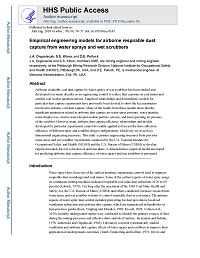Mining Publication: Empirical Engineering Models for Airborne Respirable Dust Capture from Water Sprays and Wet Scrubbers
Original creation date: October 2018
Authors: J Organiscak, S Klima, DE Pollock
Airborne respirable coal dust capture by water sprays or wet scrubbers has been studied and developed over many decades as an engineering control to reduce dust exposure in coal mines and combat coal worker pneumoconiosis. Empirical relationships and deterministic models for particular dust capture experiments have previously been devised to show the key parameters involved in airborne coal dust capture. Many of the results from these models show that the significant parameters related to airborne dust capture are water spray pressure, water quantity, water droplet size, relative water droplet-to-dust particle velocity, and total operating air pressure of the scrubber. However, many airborne dust capture efficiency relationships and models developed for particular experiments cannot be readily applied to forecast the dust collection efficiency of different spray and scrubber design configurations, which rely on several key dimensional engineering measures. This study examines engineering measures from previous water spray and wet scrubber experiments conducted by the U.S. National Institute for Occupational Safety and Health (NIOSH) and the U.S. Bureau of Mines (USBM) to develop empirical models for wet collection of airborne dusts. A dimensionless empirical model developed for predicting airborne dust capture efficiency of water sprays and wet scrubbers is presented.

- Control of Respirable Dust
- Developing and Improving Respirable Dust Controls in Coal Mines
- Effects of Water Sprays Used With a Machine-Mounted Scrubber on Face Methane Concentrations
- Equivalency of a Personal Dust Monitor to the Current United States Coal Mine Respirable Dust Sampler
- Evaluation of the Approach to Respirable Quartz Exposure Control in U.S. Coal Mines
- Investigation of Coal Properties and Airborne Respirable Dust Generation
- Miners' Views about Personal Dust Monitors
- Miners' Views About Personal Dust Monitors
- Respirable Quartz Hazard Associated with Coal Mine Roof Bolter Dust
- Using Water Sprays to Improve Performance of a Flooded-Bed Dust Scrubber